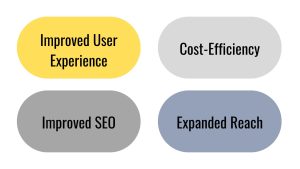Responsive Design: Seamless Experience
Introduction In today’s digital age, users interact with websites and apps on a variety of devices, from smartphones and tablets to laptops, desktops, and even smart TVs. This...

Introduction
In today’s digital age, users interact with websites and apps on a variety of devices, from smartphones and tablets to laptops, desktops, and even smart TVs. This diverse landscape has made it important for companies to ensure that their digital platforms offer a seamless experience, regardless of screen size or device. That’s where responsive web design (RWD) comes into play. Responsive design has become a cornerstone of modern web development, allowing websites to adapt and provide an optimal viewing experience across a wide range of devices.
The Importance of Responsive Design
Responsive web design is more than just a trend; it’s a necessity in our multi-device world. With the growing diversity of devices, each with a different screen size and resolution, a “one size fits all” approach to web design is no longer possible. Here’s why responsive design is critical.

1. Improved User Experience
Users expect a seamless experience when visiting a website, whether they’re using a smartphone, tablet, or desktop computer. Responsive design ensures easy access to content, intuitive navigation, and a consistent overall user experience across all devices. A positive user experience can lead to higher engagement, increased time spent on site, and ultimately better conversion rates.
2. Improved SEO
Search engines like Google prioritise websites that offer a good user experience across all devices. Responsive web design is a crucial factor in achieving this, as it reduces bounce rates and increases dwell time, both of which are important ranking factors. Additionally, a single responsive site is easier to manage from an SEO perspective than having separate mobile and desktop versions.
3. Cost-Efficiency
Maintaining separate versions of a website for different devices can be time-consuming and expensive. Responsive design streamlines the development process by allowing businesses to manage a single website that works across all platforms. This not only reduces development and maintenance costs, but also ensures a consistent brand experience.
4. Expanded Reach
With mobile internet usage outpacing desktop usage, a significant portion of your audience is accessing your website from mobile devices. Responsive design ensures that you can effectively reach and engage this audience, expanding your reach and potential customer base.
Key Principles of Responsive Design
To create a truly responsive website, there are a few key principles to consider during the design and development process. These principles will ensure that your website not only looks great on all devices, but also runs smoothly.

1. Fluid Grids
A fluid grid is the foundation of responsive design. Unlike fixed-width layouts, fluid grids are flexible and scalable, allowing the design to adapt to different screen sizes. Elements in a fluid grid are defined in relative units like percentages, rather than absolute units like pixels. This flexibility ensures that the layout will adjust smoothly to the screen size.
2. Flexible Images
Images are an essential part of web design, but they can present a challenge when it comes to responsiveness. To ensure that images scale properly, they need to be flexible. This can be achieved using CSS techniques like setting the max-width to 100% so that images dynamically resize to fit the screen size. Additionally, modern web practices include the use of responsive image techniques such as ‘srcset’ and ‘image’ elements, which allow different image resolutions to be served depending on the device’s screen density.
3. Media Queries
Media queries are a powerful tool in responsive web design, allowing developers to apply different styles based on the user’s device characteristics such as screen width, height, orientation, and resolution. Using media queries, you can create breakpoints in your design where the layout changes to accommodate different screen sizes. For example, you might have one layout for screens smaller than 768px (tablets and phones) and another for screens larger than 1024px (desktops).
4. Responsive Typography
Typography plays an important role in the readability and overall aesthetics of a website. In responsive design, it is important to ensure that the text is legible on all devices. This can be achieved by using relative units such as em or rem for font sizes that scale based on the user’s default font size settings. Additionally, line height, spacing, and contrast should be adjusted to provide an optimal reading experience on different screen sizes.
5. Mobile-First Approach
The Mobile-First approach is a design strategy in which the design process starts with the smallest screen size and then gradually improves the design for larger screens. This approach ensures that the core content and functionality is accessible on mobile devices, which often have more limitations in terms of screen size and processing power. Once the mobile experience is robust, additional features and enhancements can be added for larger screens.
Challenges in Implementing Responsive Design
While the benefits of responsive design are clear, implementing it comes with its own set of challenges. Here are some common hurdles that developers and designers may face:
1. Complex Navigation
Designing navigation that works seamlessly across all devices can be challenging. What works well on a desktop may not be as intuitive on a mobile device. Responsive design requires careful consideration of how navigation menus are displayed, often requiring solutions like collapsible menus, hamburger icons, or bottom navigation bars on smaller screens.
2. Performance Optimisation
Responsive websites should load quickly on all devices, including those with slower internet connections. Large images, videos, and complex scripts can slow down load times, especially on mobile devices. Performance optimisation includes techniques like lazy loading, image compression, and minimising the use of heavy scripts to ensure a fast, responsive experience.
3. Cross-Browser Compatibility
Ensuring that responsive design works the same across all browsers and devices is a major challenge. Each browser may display elements differently, leading to inconsistencies in the user experience. Thorough testing across browsers and devices is essential to identifying and fixing these issues.
Conclusion
Responsive web design is no longer an optional extra; it is a fundamental requirement for any website or app in today’s multi-device world. By adopting responsive design, businesses can ensure that their digital platforms provide a seamless experience across all devices, increasing user satisfaction, improving SEO, and expanding reach. While the path to a fully responsive website can be challenging, following the key principles and best practices outlined in this article will help you create a design that is both beautiful and functional, no matter the screen size.